Last Updated on January 15, 2025 by Pinax Team
If you’re new to The Graph and not a developer, this overview is for you.
TL;DR: Curious about The Graph but not sure who to ask? This post will teach anyone—especially non-technical people—about The Graph, what it does, who operates the network, and why it’s important.
This post is your chance to learn about The Graph at a basic level. Treat it as your non-technical entry point to understanding The Graph, some of its uses, and why it’s important.
What is The Graph?
Put simply, The Graph organizes blockchain data so we can access and retrieve it.
Accessing data from a blockchain is difficult because, while similar to a database, a blockchain doesn’t store data in a format that makes it easy to retrieve. Blockchain data is distributed and stored in blocks that are linked together.
Let’s break it down
If we look at The Graph’s description, we find:
The Graph is a decentralized protocol for indexing and querying blockchain data.
What is The Graph? (docs)
For those who aren’t technical or used to these terms, it seems to get complicated fast. So let’s take a closer look.
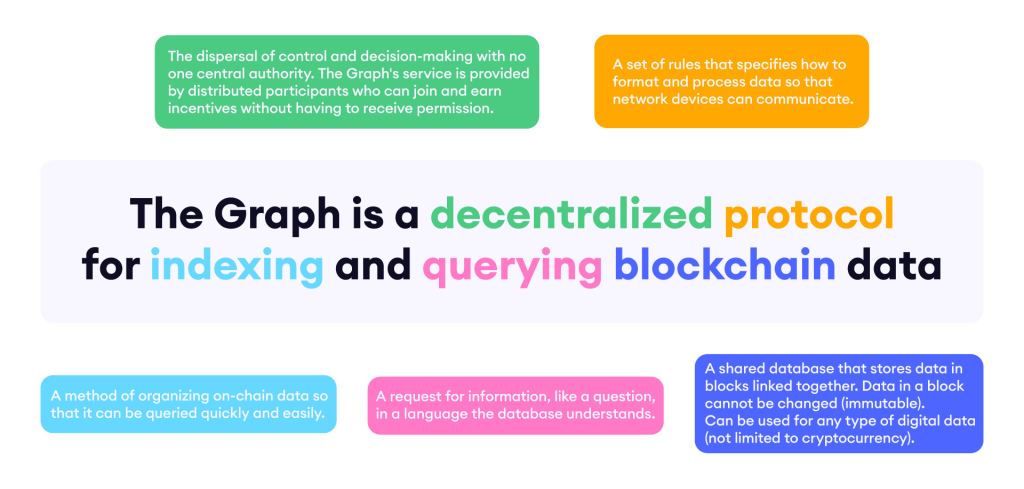
The Graph’s indexing protocol is decentralized so developers can freely build using its open source software. The indexing service is also decentralized: it’s provided by a dispersed community of participants who can join and earn incentives without permission from any central entity.
What’s in blockchain data?
So, we understand that The Graph helps organize and simplify access to blockchain data. But what does this data contain? One example is the block transactions you can find in block explorers like Etherscan. The Graph also makes blockchain data available for use in decentralized applications (dApps) and other uses like dashboards and data analytics.
💡 A block explorer is an online tool for searching for real-time and historical information about a blockchain.
The Google of blockchain
One way to explain The Graph is to call it “the Google of blockchain.” Google makes searching the internet and finding what we’re looking for fast and simple. Its search engine constantly looks for webpages to add to its index. The Graph indexes blockchain data and makes it available to developers by making it easy to query. So, what Google does for the internet, The Graph does for blockchain.
How does The Graph work?
Instead of going into the technical inner workings of The Graph, let’s cover a few ways that it’s used to retrieve data from the blockchain.
Pulls data from a blockchain
The Graph enables developers to send blockchain data to their decentralized applications (dApps).
The dApp speaks to a subgraph to get the data. A subgraph is an open-source API that a developer builds on The Graph Network so that their application can request the right data. It’s like a customized search engine for blockchain data.
💡 An API, or application programming interface, is a set of guidelines that enables software applications to talk to each other to exchange data.
So subgraphs allow communication between the dApp and the blockchain. Subgraphs can be queried using GraphQL query language (GraphQL is how the queries, or requests for information, must be phrased), and the requested data is retrieved. You can think of a subgraph as the “backend” of an application.
Pulls data from open storage and oracles
Subgraphs can also pull data from decentralized storage like Arweave or IPFS, and from oracles that bring off-chain data onto a chain. This makes it easier for developers to query and use this data in their applications.
Pulls transformed data for insights
The Graph also helps make blockchain data easier to understand and use. For example, it allows you to calculate running totals or track changes over time, such as the total number of users or block transactions. These data transformations are made possible with subgraphs and provide useful insights and analytics.
Roles on The Graph Network
A community of participants works together to make The Graph Network a success.
And here’s the cool twist. These people are not hired by The Graph. They don’t need permission to participate. Anyone can join the network and play a part. They’re incentivized and rewarded by doing good work according to their abilities.
Not everyone can be an indexer, as it requires a technical skillset that you would need to learn before you can effectively participate, but almost anyone can delegate—all you need is some GRT tokens and a bit of knowledge.
💡 GRT is the token developers use to pay for queries, and indexers and delegators use and earn on The Graph Network.
Here are the current roles:
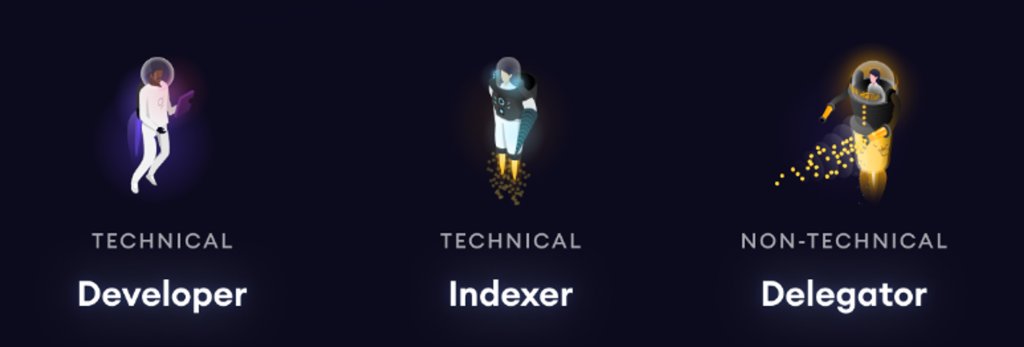
🛠️ Developer
A technical role that grows the network by building subgraphs and dApps that use blockchain data.
- Builds subgraphs and publishes them to The Graph Network.
- Queries subgraphs with GraphQL to power their applications.
- Adds signal to their subgraphs to encourage indexing.
📓 Read more on developing.
💡 Signal is GRT associated with a specific subgraph that tells indexers it is important and high quality (i.e., the subgraph is worth indexing). Subgraph owners or developers add signal to their subgraphs, making them more likely to be indexed.
🗂️ Indexer
A technical role that organizes data for efficient retrieval, reliably indexing subgraphs and serving queries to attract delegators.
- Indexes subgraphs and makes them available to be queried (a subgraph cannot be queried until it is indexed).
- Serves queries on the network (from dApps).
- Incentivized by query fees and indexing rewards that they earn for their services.
📓 Read more on indexing.
💡 Pinax is an indexer and developer on The Graph Network. We’ve built several subgraphs, including those that index historical blobs. We also provide blockchain data streaming and query services for web3 developers and data analysts.
🤝 Delegator
A non-technical role that empowers indexers to process more queries on more subgraphs, improving the health and success of the network.
- Delegates GRT, which means they place their GRT with one or more indexers, who use that GRT (without taking ownership) to allocate to subgraphs.
- Allocating GRT is when indexers place GRT on specific subgraphs, pooling with other indexers’ allocations, and they are rewarded based on the combined signal amount and weighted contributions.
- Earns a portion of an indexer’s query fees and indexing rewards by delegating to them.
- Uses their judgment and other factors to choose which indexers to delegate to, as their delegation is like a vote of confidence that shows support for an indexer.
📓 Read more on delegating.
💡 For more on indexing and delegating, watch this quick video by The Graph, Quick Overview of Indexing and Delegating.
Why is The Graph important?
The Graph is working to enable web3 and a more empowered, transparent, and trusted internet where everyone—techies and non-techies—can participate and contribute.
In Web 2.0, we have an interactive internet where we create and share our content and post to social media platforms, but a few massive companies run most of the software that we use. Those companies own and control our data.
Many have used the phrase below, including Chris Dixon, to highlight part of the problem with Web 2.0:
If it’s free, you are the product.
When we access a service like social media for free, our data and attention become the merchandise that companies sell to advertisers.
The Graph is enabling web3 to decentralize the internet. Right now, you can query blockchain data without relying on a centralized service provider, and the goal is to expand this capability to all types of information.
Incoming… more data services!
The Graph is evolving to enable new data services. It plans to expand beyond subgraphs to serve all the world’s data needs. Integrating rapid blockchain data streaming, web3 AI services, and an open, verifiable information system (as knowledge graphs) are all in development.
As these data services become available on the network, the roles we outlined above will evolve to serve them. Developers, indexers, and delegators will have massive opportunities to specialize and grow with the ecosystem.
Examples:
- Developers will be able to build and permissionlessly add a new data service to the network.
- Indexers may choose to continue indexing subgraphs, but they may also specialize in a specific area, e.g., focus on providing faster data flow, the resources to host and run AI models, or indexing data in knowledge graphs.
- Delegators may take on a more critical and impactful role with a new approach to delegation.
A final note
This article doesn’t provide comprehensive coverage of The Graph, how it works, and why it’s important. There’s so much more to know! This content is geared toward non-technical people who are new to The Graph. Our goal is that this simple overview provides an entry point into The Graph and web3 and propels you to continue your learning to get a fuller picture.
Learn & explore more
We’ve collected some quick and easy resources below and invite you to watch our blog for more articles in this Web3 Made Simple series.
Stay current on what’s happening in The Graph ecosystem by watching The Graph Espresso, our fast and focused news show on YouTube.
Curated resources for beginners:
- What is The Graph? video by The Graph
- What is The Graph? video by The Graph Academy
- The Graph – Google of Blockchains? video by Finematics
- What Is The Graph? article by Binance Academy
- Blockchain Glossary by Consensus
💡 This article answers questions like:
- What is The Graph?
- What does blockchain data contain?
- How does The Graph work?
- What's a subgraph?
- What do developers build on The Graph?
- What's an indexer?
- What's a delegator?
- What data services are coming to The Graph?
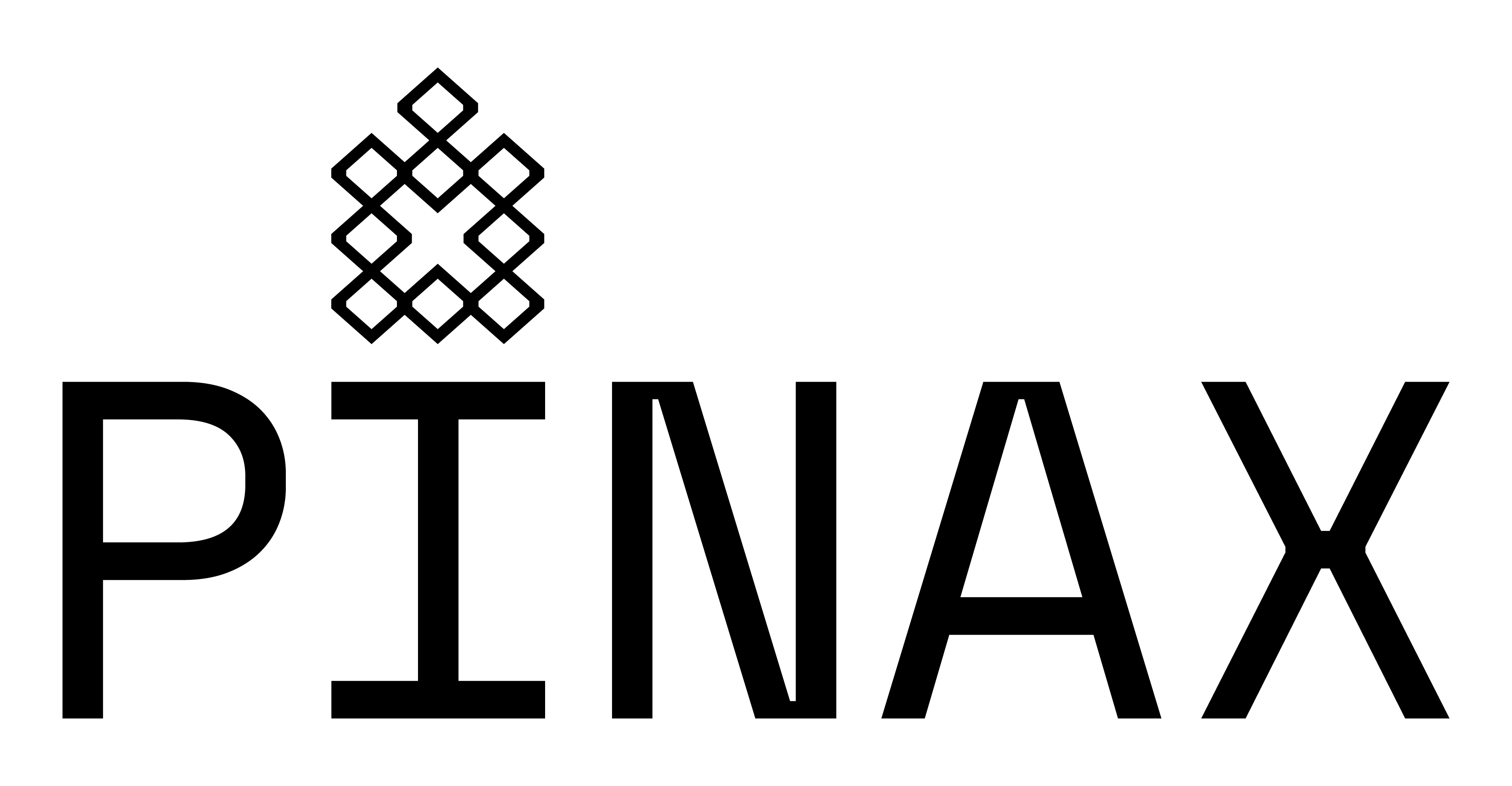

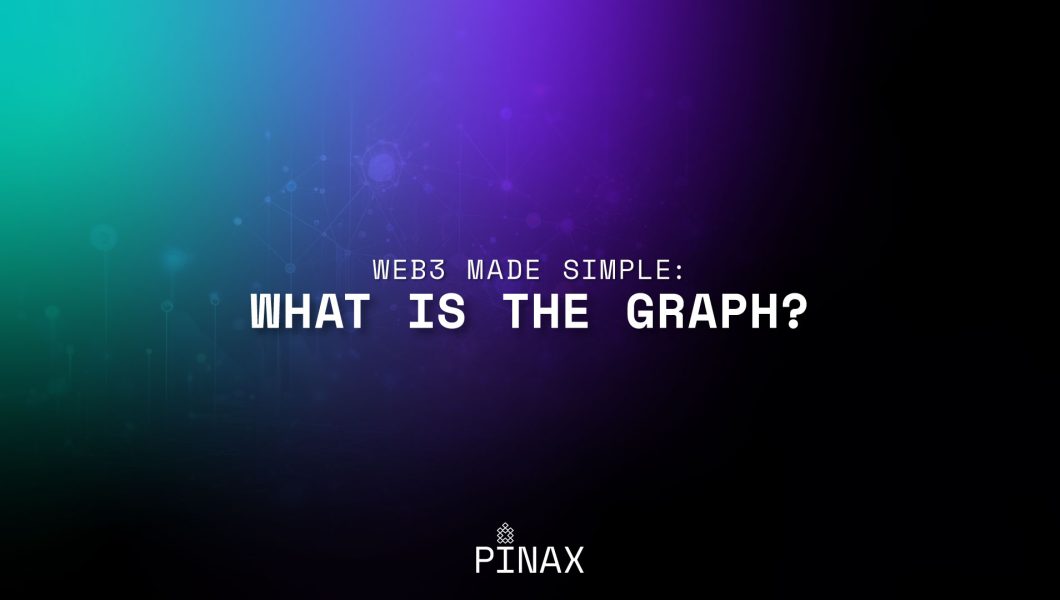


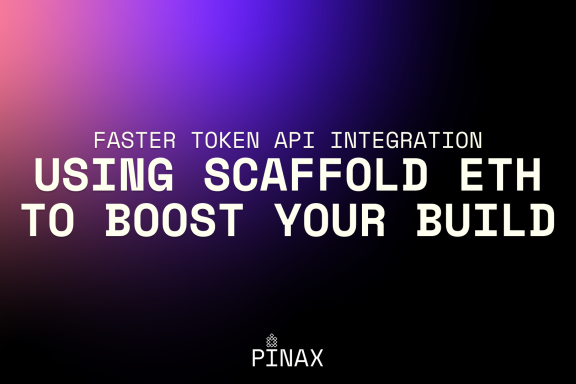
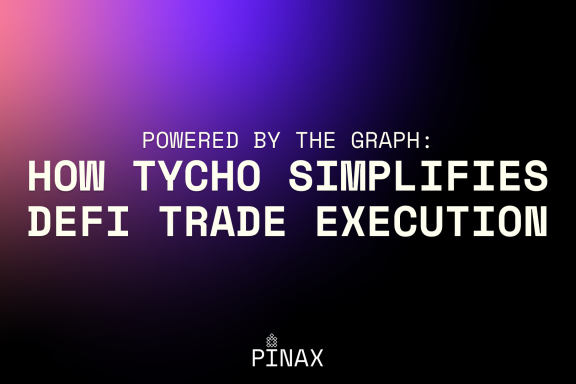
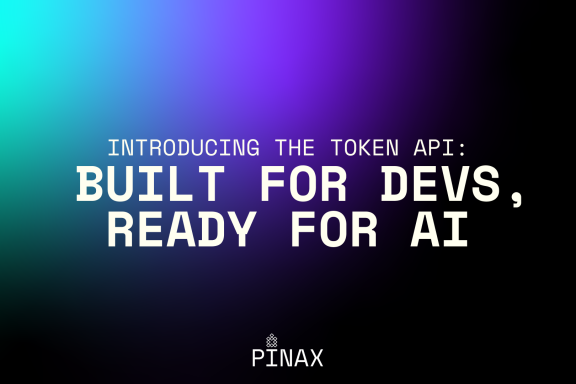
I want to learn web 3
Pinax is definitely a place to start Solomonz11, you should also check out the Substreams Series on YouTube, it’s by Pinax also, here: https://www.youtube.com/playlist?list=PLQ2cg2fSXruEpBlIi-vYJgpb7v2OtDY3n if you’re ready to code!